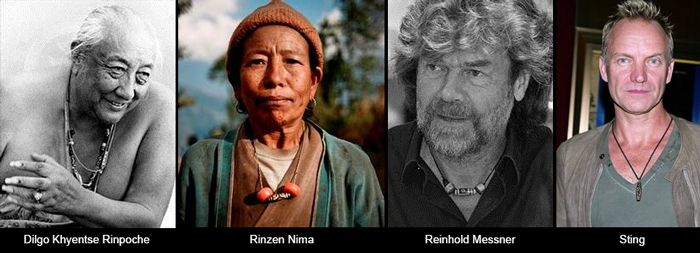
The meaning of the Tibetan word ” Dzi ” translates to ” shine , brightness , clearness, splendor. ” In Chinese it is called ” the pearl of heaven” ( ?) . The number of “eyes” on the stone is considered significant ; cover the points on designed circular grain . Depending on their number and arrangement, represent different meanings. Twelve is the highest number of eyes on an ancient Dzi . Any agate with more than twelve eyes is considered to be traditional nor authentic . The various stories or explanations that accompany the supposed benefits of Dzi with over thirteen eyes are believed to be false since they are part of the strategy employed around these sacred stones . The Dzi may appear in different colors , shapes and sizes , the surface is generally smooth and waxy , due to the use for long periods of time . Some points of color in Dzi are referred to as ” blood spots ” are small red spots in the white areas indicate a high concentration of cinnabar . This detail is highly desirable , but relatively rare. Another desirable effect is the so-called ” skin Naga ” which refers to a small circular marks on the atmospheric surface of the stone that resemble ladders . Some Dzi beads are simply polished agate using natural substances that do not have any special decorations. Dzi stones began with the tradition of Bon , the ancient animistic religion of Tibet, about 4000 years ago , but made their first appearance in history between 2000 and 1000 BC , in ancient India : a few hundred thousand warriors were reported by Tibetans from Persia or ancient Tajikistan at the end of a bloody battle . The widespread fear of the ” evil eye ” in retaliation of the vanquished was taken seriously, so those who owned the Dzi talisman , created with “eyes” on the surface could get a powerful form of spiritual protection against the enemies called ” fire fighting the fire. ” The first meteorites were small Dzi bead in tubular form , others in natural chalcedony both training they were found on the peaks of the Himalayas to the religious, spiritual preceptors or shamans. Looking at the great mystical properties of these objects the original creators considered the ‘ stone of agate as the basis for future elaboration of effective amulets. The shapes, eyes , and lines have been added to the rear with ancient methods that are not yet fully understood ; it is believed that the ‘ blackening and some of the lines Dzi emerge with plant sugars , heat, grease , clay , wax, or similar substances . After the color , shape and decoration of the ‘ agate has been reached , the filmmakers would drill the hole , a difficult job because in ancient times was to be introduced into thin strands . The softness and the absence of cracks in the stones imply that the processes of heating and bleaching took place at high altitude ( altitude Himalayan ) or some sort of ancient and rudimentary vacuum chamber with processing craft sophisticated and high precision . Although the geographic origin of Dzi beads is uncertain , it is recognized that in actuality are called ” Tibetan beads , ” just as “the Tibetan coral ” , arrived in Tibet to far off places. The Tibetans love these items and consider them gems hereditary . Due to their fascinating story ” stones falling from the sky ” have survived for many centuries, from generation to generation are worn by miles of believers , individuals of rural people of Tibet, Bhutan , Nepal , Ladakh , Sikkim and Mongolia. Some Dzi are still found by peasants and shepherds during the short summer, when it melts the cusps lie on the world’s highest ; are agates that were worn wires using vegetable weak because too small to be placed on leather thongs are more resistant . Amulets lost in time by travelers or by caravans were waiting for a new owner to protect. Since the knowledge of the Dzi stone is derived from the oral tradition , the gems in Shangri – Lha have caused controversy on their origin , their method of manufacture and also their precise definition . The Tibetan culture continues to believe that this agate recalls the legendary dharmapala protection , guards otherworldly , enlightened beings ” Chos Skyong ” , the deity of ‘ environment , the ancestors , the bodhisattvas , and demons who swore to protect the faithful Buddhists and animists Bon .




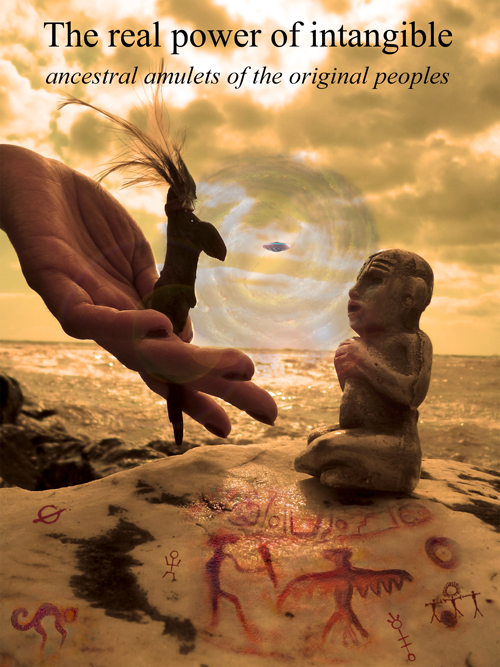
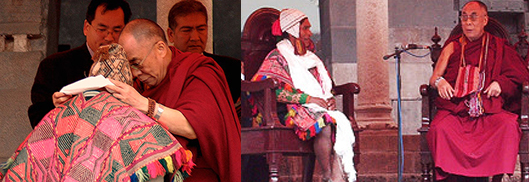
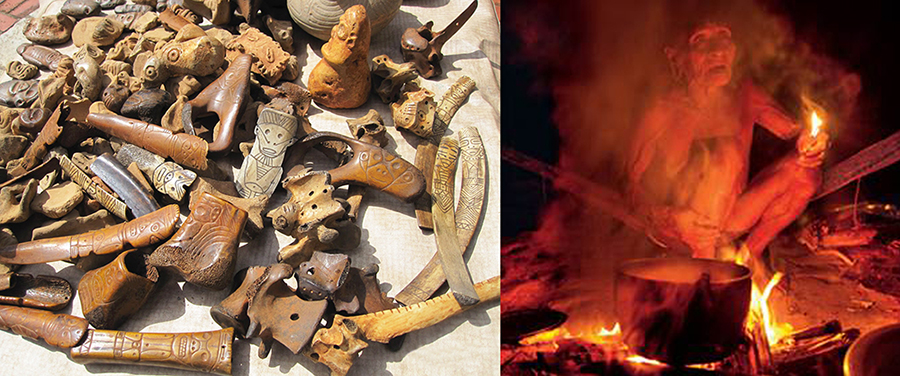
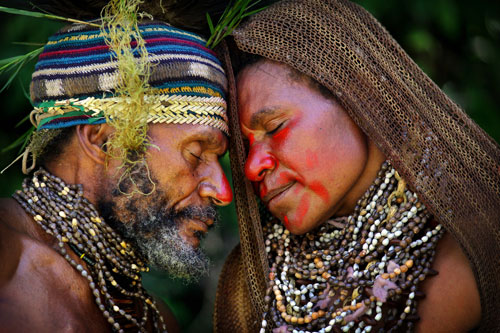

 The choice as agate amulet is not accidental: the stones , such as metals, are conductors of energy and agate from time immemorial is considered a stone that radiates positive energy , for this reason it is suitable to become a good support physical / material which is associated with the mystical symbolism . Formed from a single tubular segment with specific symbolic reasons, the first models appeared in the chronicles Dzi were introduced in Tibet by warriors from Persia . Represented the extreme skill of the craftsmen engraving Persian , derived from techniques already been lost, and difficult to imitate .. The true origin of this stone is unknown. Stories passed down from generations tell of crushed meteorites found over four million years ago in Tibet , Bhutan, Sikkim and Ladhak before spreading throughout the region of Asia and the Himalayan centrale.Gli Dzi can also be agates natural shapes and patterns that are not etched falling within the sacred symbology Tibetan , in these cases their value is very high. After the exile of the Dalai Lama the first Tibetans who left for the United States used the Dzi to pay for hospitality or services received , given the lack of money. Acune of these stones have been preserved in the Metropolitan Museum of Art in New York. In the culture of the Tibetan ” Dzi ” are considered a blessing, a symbol of great social prestige and a very powerful amulet : not only are worn as pendants or bracelets just to protect the person, but in the ancient and the most traditional Tibetan medicine ” Dzi ” were crushed and the powder used as an ointment or diluted in particular drinks healing . Even today you can find examples of ” Dzi ” chipped or broken, are those in which a part has been removed for use as a medicine. Also adopted by the Chinese culture, ” Dzi ” became the name of ” stone of heaven ” as the correct translation would refer to a set of ” purity , splendor , brightness and brightness .
The choice as agate amulet is not accidental: the stones , such as metals, are conductors of energy and agate from time immemorial is considered a stone that radiates positive energy , for this reason it is suitable to become a good support physical / material which is associated with the mystical symbolism . Formed from a single tubular segment with specific symbolic reasons, the first models appeared in the chronicles Dzi were introduced in Tibet by warriors from Persia . Represented the extreme skill of the craftsmen engraving Persian , derived from techniques already been lost, and difficult to imitate .. The true origin of this stone is unknown. Stories passed down from generations tell of crushed meteorites found over four million years ago in Tibet , Bhutan, Sikkim and Ladhak before spreading throughout the region of Asia and the Himalayan centrale.Gli Dzi can also be agates natural shapes and patterns that are not etched falling within the sacred symbology Tibetan , in these cases their value is very high. After the exile of the Dalai Lama the first Tibetans who left for the United States used the Dzi to pay for hospitality or services received , given the lack of money. Acune of these stones have been preserved in the Metropolitan Museum of Art in New York. In the culture of the Tibetan ” Dzi ” are considered a blessing, a symbol of great social prestige and a very powerful amulet : not only are worn as pendants or bracelets just to protect the person, but in the ancient and the most traditional Tibetan medicine ” Dzi ” were crushed and the powder used as an ointment or diluted in particular drinks healing . Even today you can find examples of ” Dzi ” chipped or broken, are those in which a part has been removed for use as a medicine. Also adopted by the Chinese culture, ” Dzi ” became the name of ” stone of heaven ” as the correct translation would refer to a set of ” purity , splendor , brightness and brightness .
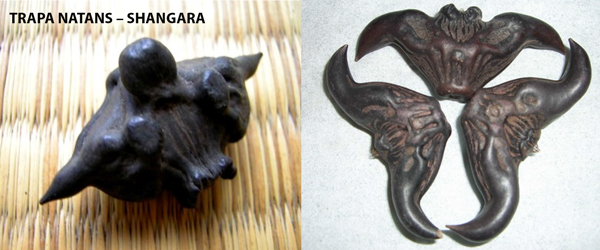 Cultivated in China and India, by at least 3,000 years, this aquatic plant is also known to Tibetans . He arrived in Italy and Europe from ‘ Asia in medieval times, grows wild in marshy areas . From the distant past is also known for its food use ; were recently found fossils of its fruits already known and used as food by the men of the Neolithic. In the summer, each flower becomes a fruit that has a single large seed and fleshy , its wooden body contains starch. The Latin name ” Trapa Natans ” refers to a device of iron spiked with four fronts that ancient Roman soldiers tossed in the paths of the horses to injure their feet. Known in India by the name of Sanghara , this plant has pharmacological properties , is widely used in Ayurvedic medicine . The particular shape of the dried fruits gives it a mysterious appeal to lovers of ‘ occult and magic. In China, its shape and its characteristics are considered auspicious. The bat is a lucky animal , because the name “Bat” ( It was ) just sounds like the word for ” happiness ” ( Fuu ), so the people of China know the trapa natans as Ling Nut , and is considered a lucky food to eat .
Cultivated in China and India, by at least 3,000 years, this aquatic plant is also known to Tibetans . He arrived in Italy and Europe from ‘ Asia in medieval times, grows wild in marshy areas . From the distant past is also known for its food use ; were recently found fossils of its fruits already known and used as food by the men of the Neolithic. In the summer, each flower becomes a fruit that has a single large seed and fleshy , its wooden body contains starch. The Latin name ” Trapa Natans ” refers to a device of iron spiked with four fronts that ancient Roman soldiers tossed in the paths of the horses to injure their feet. Known in India by the name of Sanghara , this plant has pharmacological properties , is widely used in Ayurvedic medicine . The particular shape of the dried fruits gives it a mysterious appeal to lovers of ‘ occult and magic. In China, its shape and its characteristics are considered auspicious. The bat is a lucky animal , because the name “Bat” ( It was ) just sounds like the word for ” happiness ” ( Fuu ), so the people of China know the trapa natans as Ling Nut , and is considered a lucky food to eat .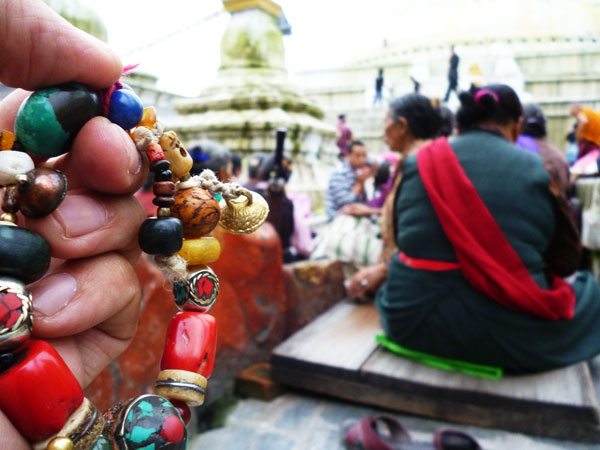 For millennia , the rural cultures of Tibet, Nepal , Bhutan and Mongolia, have worn the bracelets Theng ngnà , these amulets have for each element a correct interpretation of mystical meanings . They are symbols of respect and veneration, which are used by the monks, shamans, animists rural people and nomadic tribes in remote regions of the Himalayas. According to careful scholars of ancient Tibetan iconography as Nebesky – Wojkowitz, writers on the origin of the ancestral deities, knowledge of these amulets are transmitted orally in the Nordic region of Amdo, in Thang-Lha (Byang Thang) at the foot of the Sacred Mountain Yar – Lha – Sham – Po, there is little information available outside of this context, there are not names and dates specified in Tibetan mythology. Many details have disappeared over time, this makes us see how the popular landmark is the only witness, the rites and traditions concerning the gods of the four mountains. It is said that God Yar – Lha – Sham – Po (pre-Buddhist deities for the nomadic tribes of the Yar and the rest of the Tibetan population), had given a wise healer Bon-po, the task of creating a powerful talisman that contained elements of light, sacred stones of the mountain, three metals, “Dzi” the jewel fell from the sky, plants with many beneficial properties, and containing the three main colors merged into white light. The amulet was to be able to give from the heart of the people, the celestial energy and spiritual virtues. Blue Lapis= Will, Yellow Amber= Wisdom, Red coral=Action. For the Himalayan population the metals and stones have different characteristics with regard to the irradiation of energy. According to the myth, the God Yar-Lha-Sham Po, has extraordinary magical powers, rides a white yak. From the mouth and nostrils of the mighty animal out lightning and thunder that give rise to snow avalanches. This deity of the mountain can destroy the big rocks of the cliffs, it turns into a white man who arouse sensual passion of women and girls of the villages and regions. In the Tibetan historiology God Yar-Lha-Sham Po is called the noble gods, and represents the power of the royal family. Before Buddhism, members of the nobility worshiped the deities of Bon; these families ancestors were using stones, symbols and amulets protectors Theng Ngnà. For a long time they remained faithful to these particular amulets that also possessed a secret ingredient. In Tibetan mythology the divine images of amulets are identified with religious elements, rather than on the same mountain (considered deities). The gods of the Tibetan pantheon are imbued with the energy of the animist and Buddhist mysticism, represented in rocks, animals, ancestors, paintings, symbols and amulets.
For millennia , the rural cultures of Tibet, Nepal , Bhutan and Mongolia, have worn the bracelets Theng ngnà , these amulets have for each element a correct interpretation of mystical meanings . They are symbols of respect and veneration, which are used by the monks, shamans, animists rural people and nomadic tribes in remote regions of the Himalayas. According to careful scholars of ancient Tibetan iconography as Nebesky – Wojkowitz, writers on the origin of the ancestral deities, knowledge of these amulets are transmitted orally in the Nordic region of Amdo, in Thang-Lha (Byang Thang) at the foot of the Sacred Mountain Yar – Lha – Sham – Po, there is little information available outside of this context, there are not names and dates specified in Tibetan mythology. Many details have disappeared over time, this makes us see how the popular landmark is the only witness, the rites and traditions concerning the gods of the four mountains. It is said that God Yar – Lha – Sham – Po (pre-Buddhist deities for the nomadic tribes of the Yar and the rest of the Tibetan population), had given a wise healer Bon-po, the task of creating a powerful talisman that contained elements of light, sacred stones of the mountain, three metals, “Dzi” the jewel fell from the sky, plants with many beneficial properties, and containing the three main colors merged into white light. The amulet was to be able to give from the heart of the people, the celestial energy and spiritual virtues. Blue Lapis= Will, Yellow Amber= Wisdom, Red coral=Action. For the Himalayan population the metals and stones have different characteristics with regard to the irradiation of energy. According to the myth, the God Yar-Lha-Sham Po, has extraordinary magical powers, rides a white yak. From the mouth and nostrils of the mighty animal out lightning and thunder that give rise to snow avalanches. This deity of the mountain can destroy the big rocks of the cliffs, it turns into a white man who arouse sensual passion of women and girls of the villages and regions. In the Tibetan historiology God Yar-Lha-Sham Po is called the noble gods, and represents the power of the royal family. Before Buddhism, members of the nobility worshiped the deities of Bon; these families ancestors were using stones, symbols and amulets protectors Theng Ngnà. For a long time they remained faithful to these particular amulets that also possessed a secret ingredient. In Tibetan mythology the divine images of amulets are identified with religious elements, rather than on the same mountain (considered deities). The gods of the Tibetan pantheon are imbued with the energy of the animist and Buddhist mysticism, represented in rocks, animals, ancestors, paintings, symbols and amulets.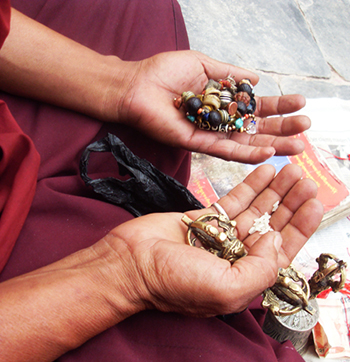 Consecration of the amulet
Consecration of the amulet Ancient sacred texts such as the Sutra of Omnipresence refer to “five poisonous eyes of evil,” bad thoughts and traps of jealousy. He asserts that “the strategy of ‘ eye for an eye” revenge, would be the cause that would create bad karma . It is believed that objects such as agate Dzi beads , necklaces made of turquoise , coral, amber etc . adorned the most important and revered statues. Cosmology and Buddhist teachings on ‘ soul explain that it is the substance of the human spiritual , higher , eternal and unchanging , identical to the “I” . The ‘ soul decreed the act of nature , the same nature and its elements provide strength and protection. Shamans Himalayan state that nature has a conscience and their own business , and energy forms in the universe . The components of Theng ngna ‘ are unintelligent and can not have their own will , therefore , there must be a cause them awakenings , making them active , making trigger the potential inherent in each stone or metal. The act of this cause is the ‘ intention of those who gave shape, the sound vibration of his prayers in the ‘ geographical environment . The cause that gives rise to the energy of ‘ object relates to the interaction between soul and nature, creator of the object and the wearer . With its symbolism , an amulet reminds us of the way we want to follow , what we want to happen in our lives, encourages us to persevere in achieving our goal. Wear it causes us to be constantly aware of it, to stay focused . Giving attention to strive for their goals and means to achieve them. And ‘ necessary to specify that the amulets have the importance that each person gives , if you do not internalize their deep meaning in relation to his own being , it is best not to wear it . In other places of the ‘ Central Asia, Brahmins , Buddhists and Hindus believe that owning these special talismans attract positive energies and amplify the good that already exists. Passed down from generation to generation as a valuable cultural and spiritual heritage of the Theng Ngna ‘ amulets are handmade, unique and personal aimed at preserving its holders from danger , pain, wickedness and risks caused by evil spirits. According to the religious preceptors of the ancient art related to the protection invisible , are a symbol for good luck that protects its owner from disease and other dark forces considered dangerous . For a long time the information about the fascinating objects have remained a privilege of the few wise and knowledgeable of the practices related to ritualiche Bon , the ancestral doctrine that converged with other methods and hidden mystical knowledge in the areas of Qinghai, the historic land of Amdo .
Ancient sacred texts such as the Sutra of Omnipresence refer to “five poisonous eyes of evil,” bad thoughts and traps of jealousy. He asserts that “the strategy of ‘ eye for an eye” revenge, would be the cause that would create bad karma . It is believed that objects such as agate Dzi beads , necklaces made of turquoise , coral, amber etc . adorned the most important and revered statues. Cosmology and Buddhist teachings on ‘ soul explain that it is the substance of the human spiritual , higher , eternal and unchanging , identical to the “I” . The ‘ soul decreed the act of nature , the same nature and its elements provide strength and protection. Shamans Himalayan state that nature has a conscience and their own business , and energy forms in the universe . The components of Theng ngna ‘ are unintelligent and can not have their own will , therefore , there must be a cause them awakenings , making them active , making trigger the potential inherent in each stone or metal. The act of this cause is the ‘ intention of those who gave shape, the sound vibration of his prayers in the ‘ geographical environment . The cause that gives rise to the energy of ‘ object relates to the interaction between soul and nature, creator of the object and the wearer . With its symbolism , an amulet reminds us of the way we want to follow , what we want to happen in our lives, encourages us to persevere in achieving our goal. Wear it causes us to be constantly aware of it, to stay focused . Giving attention to strive for their goals and means to achieve them. And ‘ necessary to specify that the amulets have the importance that each person gives , if you do not internalize their deep meaning in relation to his own being , it is best not to wear it . In other places of the ‘ Central Asia, Brahmins , Buddhists and Hindus believe that owning these special talismans attract positive energies and amplify the good that already exists. Passed down from generation to generation as a valuable cultural and spiritual heritage of the Theng Ngna ‘ amulets are handmade, unique and personal aimed at preserving its holders from danger , pain, wickedness and risks caused by evil spirits. According to the religious preceptors of the ancient art related to the protection invisible , are a symbol for good luck that protects its owner from disease and other dark forces considered dangerous . For a long time the information about the fascinating objects have remained a privilege of the few wise and knowledgeable of the practices related to ritualiche Bon , the ancestral doctrine that converged with other methods and hidden mystical knowledge in the areas of Qinghai, the historic land of Amdo .
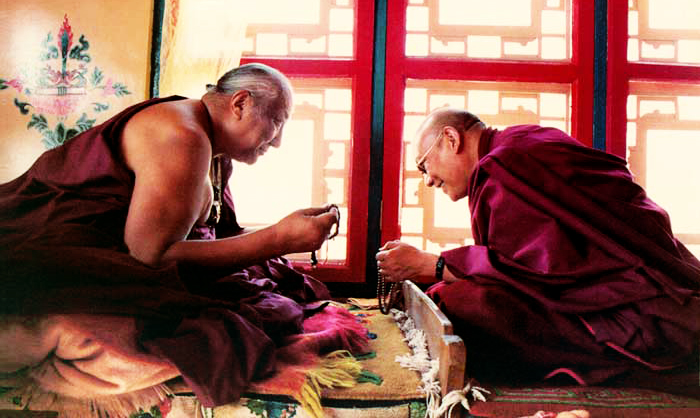 Khyense Dilgo Rinpoche (teacher of the XIV Dalai Lama) was an admirer of rare and ancient objects related to the spiritual quest, he was 12 years study and meditation in a secluded cave in the mountains of Tibet. Always wore amulets during its existence, together with Dzi Beads, Gau, bracelets and other relics dating back to the time of the historical Buddha and other masters believers. Gyalse Trulke from Satsam Chorten (in Paro, Bhutan) argues that the amulets such as tanka, mandalas and symbolic representations made by men and women of strong faith, help to illuminate living beings, they are perceived through our five senses of light and are able to liberate and protect the people. Today the Theng Ngna ‘are almost unknown to the Tibetans themselves. Their true meaning has been destroyed by the many sufferings inflicted on the people by the violent imposed by the Chinese government. Along with ancient ceremonies and rituals otherworldly these legendary amulets try to survive the insidious western modernism, die in their tracks. Hide their appearance in the definitions of the various languages, dialects and mysteries that co-exist in the rugged and majestic himalayan geography; Theng Ngna, Ga’u, Chos skyong sgrog gdung, Lackpa taya, Norbu dzi or Thog chags, are some of the many names. In 1959, after the communist invasion, the Dalai Lama fled from Tibet. The elderly Lama and officials who accompanied him in exile took with their jewelry very valuable. Coral, lapis lazuli, turquoise and amber formed, along with ritual objects, the different bracelets used as amulets. Some monks brought the mysterious stones of agate Dzi.
Khyense Dilgo Rinpoche (teacher of the XIV Dalai Lama) was an admirer of rare and ancient objects related to the spiritual quest, he was 12 years study and meditation in a secluded cave in the mountains of Tibet. Always wore amulets during its existence, together with Dzi Beads, Gau, bracelets and other relics dating back to the time of the historical Buddha and other masters believers. Gyalse Trulke from Satsam Chorten (in Paro, Bhutan) argues that the amulets such as tanka, mandalas and symbolic representations made by men and women of strong faith, help to illuminate living beings, they are perceived through our five senses of light and are able to liberate and protect the people. Today the Theng Ngna ‘are almost unknown to the Tibetans themselves. Their true meaning has been destroyed by the many sufferings inflicted on the people by the violent imposed by the Chinese government. Along with ancient ceremonies and rituals otherworldly these legendary amulets try to survive the insidious western modernism, die in their tracks. Hide their appearance in the definitions of the various languages, dialects and mysteries that co-exist in the rugged and majestic himalayan geography; Theng Ngna, Ga’u, Chos skyong sgrog gdung, Lackpa taya, Norbu dzi or Thog chags, are some of the many names. In 1959, after the communist invasion, the Dalai Lama fled from Tibet. The elderly Lama and officials who accompanied him in exile took with their jewelry very valuable. Coral, lapis lazuli, turquoise and amber formed, along with ritual objects, the different bracelets used as amulets. Some monks brought the mysterious stones of agate Dzi.
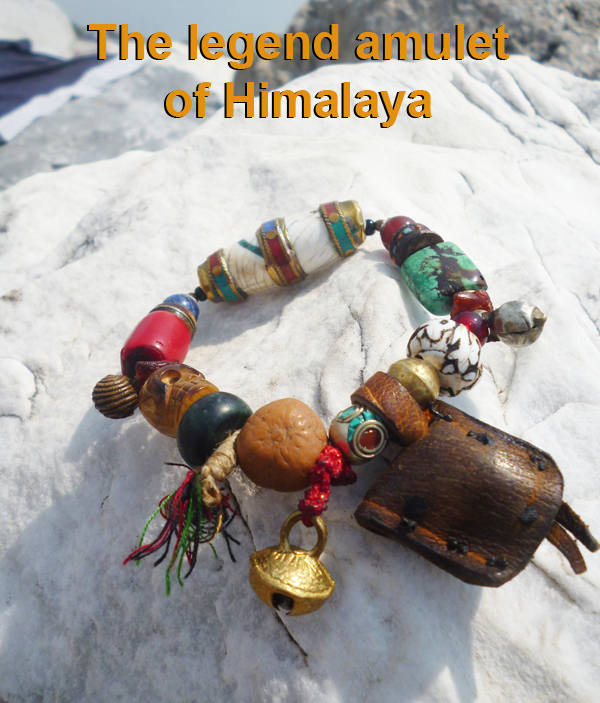 Into The shape of amulets tutelary varies according to the creators and their places of origin. Highly sought are those made by artisans and shamans of Bhutan, Tibet, Qinghai and the area of Mustang. The legends of ancient peoples are not sufficient to meet the obsession of archaeologists, anthropologists and western scholars who have long been working to find out how much truth is there in this story and how it has originated this myth handed down from generation to generation during many centuries. The classics of Hung-Chang Shih support the theory of the treasure of the Persian King brought home from the Tibetan warriors who won an impressive series of wars. Popular belief has mythologized the wonderful artifacts, people in rural villages manifested through faith their sacred meaning. The latent energy of its parts united and bright colors by carrying away, the vigor and vitality of those who through inner conviction, relying on a small amulet their safety in difficult territories, governed by the elements, places where human survival is put to the test.
Into The shape of amulets tutelary varies according to the creators and their places of origin. Highly sought are those made by artisans and shamans of Bhutan, Tibet, Qinghai and the area of Mustang. The legends of ancient peoples are not sufficient to meet the obsession of archaeologists, anthropologists and western scholars who have long been working to find out how much truth is there in this story and how it has originated this myth handed down from generation to generation during many centuries. The classics of Hung-Chang Shih support the theory of the treasure of the Persian King brought home from the Tibetan warriors who won an impressive series of wars. Popular belief has mythologized the wonderful artifacts, people in rural villages manifested through faith their sacred meaning. The latent energy of its parts united and bright colors by carrying away, the vigor and vitality of those who through inner conviction, relying on a small amulet their safety in difficult territories, governed by the elements, places where human survival is put to the test.